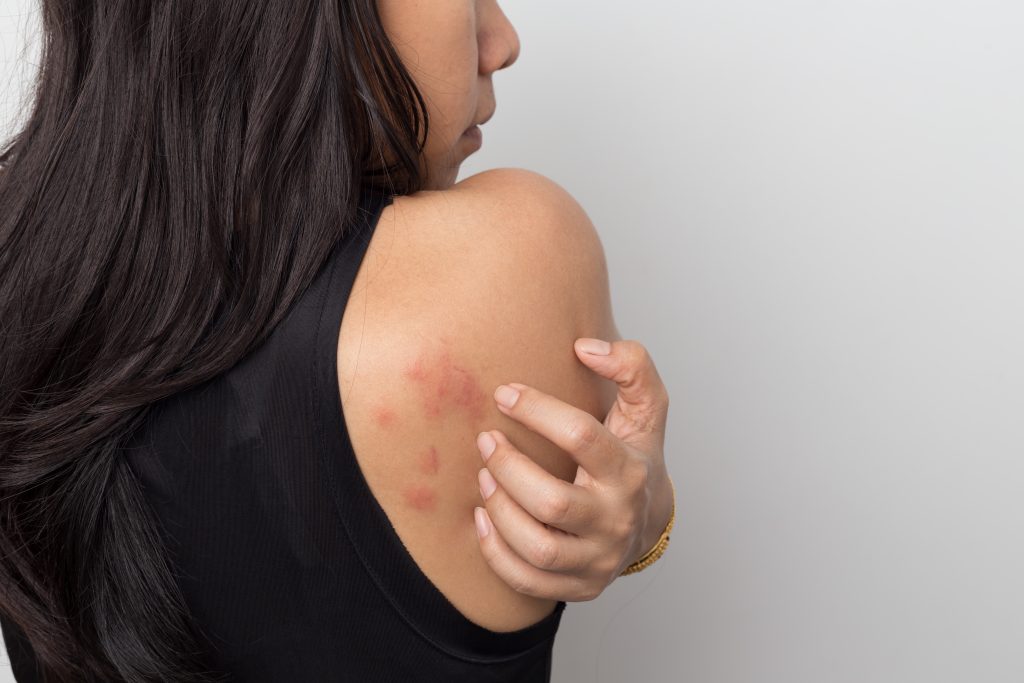
What is Contact Dermatitis?
If you’re experiencing a sudden or unusual rash, it might be contact dermatitis. Contact dermatitis, which impacts between 15% and 20% of all people, is a skin condition that causes an itchy rash or other symptoms after direct contact with, or an allergic reaction to, a substance.
When your skin touches an allergen or irritant, your immune system responds, causing your white blood cells to respond, causing rashes. These rashes can make your skin appear red, sore, inflamed, blistered, dry, or cracked. Lighter skin may turn red, while darker skin may turn dark brown, purple, or gray. The rash often appears within days of exposure, but allergic reactions can sometimes develop after months or years.
If left untreated, contact dermatitis can lead to permanent skin damage and serious infections. In chronic contact dermatitis, the skin can become dry, scaly, and thick, and skin color can change. In addition, hair loss can occur.
Causes & Symptoms
There are two common types of contact dermatitis, allergic contact dermatitis and irritant contact dermatitis.
Allergic contact dermatitis occurs when your body has an allergic reaction to a substance it does not like. It can take several days for a rash to develop.
 “Cosmetics, medicines, clothes dyes, metals like nickel, fragrances, rubber, poison ivy, and some foods can cause allergic contact dermatitis,” notes Cameron Clements, Certified Family Nurse Practitioner at Waccamaw Dermatology Skin Institute. “Allergic contact dermatitis can be hard to diagnose because we come into contact with thousands of these substances every day.”
“Cosmetics, medicines, clothes dyes, metals like nickel, fragrances, rubber, poison ivy, and some foods can cause allergic contact dermatitis,” notes Cameron Clements, Certified Family Nurse Practitioner at Waccamaw Dermatology Skin Institute. “Allergic contact dermatitis can be hard to diagnose because we come into contact with thousands of these substances every day.”
Irritant contact dermatitis, which occurs more often than allergic contact dermatitis, tends to produce a rash quickly in response to an irritating substance. “Soaps, detergents, acids, bases, and solvents are typically triggers for irritant contact dermatitis,” adds Cameron.
Symptoms may include:
- An itchy rash
- Leathery patches of skin that are darker than usual
- Dry, cracked, scaly skin
- Bumps and blisters, sometimes with oozing and crusting
- Swelling, burning, tenderness, or a stinging sensation
- Hives
The rash appears to be similar to eczema and is not contagious, but can be very uncomfortable. Contact dermatitis can spread to other parts of the body depending on the initial cause of the reaction.
Who is Prone to Contact Dermatitis?
Anyone from infants to adults can be impacted by contact dermatitis. Reactions can occur after a single exposure or exposures over time. Individuals who work in certain professions, for example, have a higher risk of developing contact dermatitis through repeated exposure to irritating chemicals or allergens.
These jobs include:
- Construction workers
- Florists
- Food handlers
- Hairstylists and cosmetologists
- Healthcare providers
- Cleaners
- Mechanics
- Artists
In general, people with sensitive skin and/or chronic skin conditions are more susceptible to developing contact dermatitis.
Prevention & Treatments
Taking the following steps can help you proactively prevent contact dermatitis:
- Avoid irritants and allergens
- Wash with soap made for sensitive skin
- Wear protective clothing or gloves
- Apply a barrier cream or gel
- Use moisturizer
- Take care around pets
If you are already experiencing mild symptoms of contact dermatitis, there are home remedies that can ease symptoms, including over-the-counter anti-itch creams or ointments, applying a cool, wet compress to the affected area, or soaking in a soothing cool bath. Additionally, it’s crucial to avoid scratching your rash and remain out of the sun while your skin heals.
Seeing your doctor is recommended if:
- The rash is so itchy you can’t sleep or have trouble performing daily activities
- The rash is severe or widespread
- You’re concerned with the appearance of your rash
- The rash doesn’t improve within three weeks
- The rash involves your eyes, mouth, face, or genitals
You should seek immediate medical care if you think your skin is infected (i.e., fever and pus oozing from blisters), it’s hard to breathe, your eyes or nasal passages hurt after inhaling smoke, or you think an ingested substance has damaged the lining of your mouth, which may also indicate damage to your digestive tract.
Diagnosis & Testing
“To determine whether you have contact dermatitis, we will first take a complete medical history, perform a physical exam, and review your symptoms,” says Cameron. “Although there is not a test to identify the cause of irritant contact dermatitis, we will ask questions about your environment, things you came into contact with, and the location and size of your rash. Allergic contact dermatitis offers more testing options including a patch test to confirm a diagnosis. Once we determine which type you have, we can create the right treatment program for you.”
Contact dermatitis is not something to take lightly, and can be extremely uncomfortable. If you are experiencing skin inflammation and rashes, give us a call to discuss your symptoms and schedule an appointment. With the right treatment and home care measures, you can live a life free of contact dermatitis.
Featured
- Mane Concerns: Understanding Hair Loss
Aug 21, 2024
- What is Contact Dermatitis?
Jul 18, 2024
- June is Acne Awareness Month
May 31, 2024
- Benefits of Individualized Skin Cancer Treatment
May 7, 2024
- Busting Myths About Fillers and Injectables
Apr 18, 2024
- Keep Retinol in Your Winter Skincare Routine – Waccamaw Dermatology Skin Institute
Jan 12, 2024
- Waccamaw Dermatology Skin Institute Holiday Gift Guide
Dec 13, 2023
- Our Not-So-Secret Summer Skincare Tips
Jul 11, 2023
- Spring Skincare Tips to Restore Your Skin
Mar 21, 2023
- Six Undeniable Benefits of Botox
Mar 1, 2023